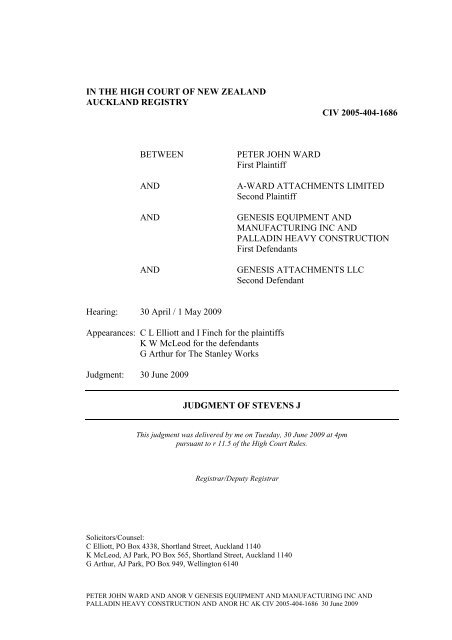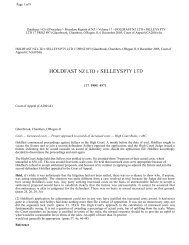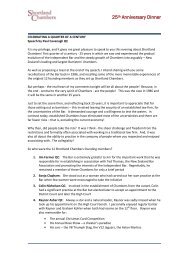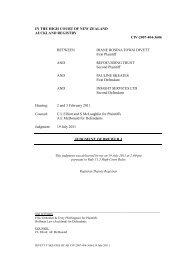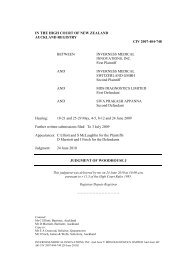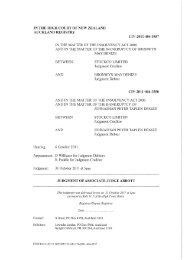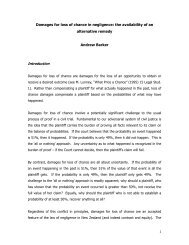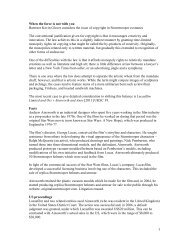Peter Ward v Genesis Equipment - Shortland Chambers
Peter Ward v Genesis Equipment - Shortland Chambers
Peter Ward v Genesis Equipment - Shortland Chambers
Create successful ePaper yourself
Turn your PDF publications into a flip-book with our unique Google optimized e-Paper software.
IN THE HIGH COURT OF NEW ZEALAND<br />
AUCKLAND REGISTRY<br />
BETWEEN PETER JOHN WARD<br />
First Plaintiff<br />
CIV 2005-404-1686<br />
AND A-WARD ATTACHMENTS LIMITED<br />
Second Plaintiff<br />
AND GENESIS EQUIPMENT AND<br />
MANUFACTURING INC AND<br />
PALLADIN HEAVY CONSTRUCTION<br />
First Defendants<br />
AND GENESIS ATTACHMENTS LLC<br />
Second Defendant<br />
Hearing: 30 April / 1 May 2009<br />
Appearances: C L Elliott and I Finch for the plaintiffs<br />
K W McLeod for the defendants<br />
G Arthur for The Stanley Works<br />
Judgment: 30 June 2009<br />
JUDGMENT OF STEVENS J<br />
This judgment was delivered by me on Tuesday, 30 June 2009 at 4pm<br />
pursuant to r 11.5 of the High Court Rules.<br />
Registrar/Deputy Registrar<br />
Solicitors/Counsel:<br />
C Elliott, PO Box 4338, <strong>Shortland</strong> Street, Auckland 1140<br />
K McLeod, AJ Park, PO Box 565, <strong>Shortland</strong> Street, Auckland 1140<br />
G Arthur, AJ Park, PO Box 949, Wellington 6140<br />
PETER JOHN WARD AND ANOR V GENESIS EQUIPMENT AND MANUFACTURING INC AND<br />
PALLADIN HEAVY CONSTRUCTION AND ANOR HC AK CIV 2005-404-1686 30 June 2009
Introduction<br />
[1] The first plaintiff has applied as patentee to amend Patent No. 517737 (the<br />
patent) entitled “Cutting or Crushing Apparatus”. The application is brought under<br />
ss 39 and 40 of the Patents Act 1953 (the Act). It is opposed by the defendants<br />
<strong>Genesis</strong> <strong>Equipment</strong> and Manufacturing Inc and Palladin Heavy Construction (the<br />
first defendants) and <strong>Genesis</strong> Attachments LLC (the second defendant) as well as<br />
The Stanley Works, a party given leave to oppose the application.<br />
[2] The patent relates to devices designed to cut and pulverise materials by using<br />
jaw attachments for excavators specifically used in the demolition and scrap<br />
recycling industry.<br />
[3] The first plaintiff is also the proprietor of a corresponding Australian patent.<br />
The Australian patent has been re-examined, a process which brought to the<br />
plaintiff’s attention prior art that may have been available to the New Zealand public<br />
before the priority date of the patent. Against this possibility, and as a precautionary<br />
step, the first plaintiff applied as patentee to amend the New Zealand patent.<br />
[4] At the start of the hearing, counsel for the opposing parties helpfully<br />
indicated that there was no dispute that the Court had jurisdiction under s 39 of the<br />
Act to make the order sought. Further, it was accepted that the proposed<br />
amendments were in proper form and were respectively disclaimers and a correction<br />
under s 40 of the Act. At issue was whether this was an appropriate case for the<br />
Court to exercise its discretion to allow the proposed amendments. In terms of the<br />
wider dispute between the parties involving allegations of infringement of the New<br />
Zealand patent, the opposing parties reserved their position as to the validity of the<br />
patent.<br />
[5] For the reasons set out below, I am satisfied that this is an appropriate case to<br />
exercise the discretion in s 39 of the Act to allow the patentee to amend the patent.<br />
The detailed order will be set out later at [71].
Factual background<br />
[6] The application to amend was filed in the High Court on 21 December 2006.<br />
This occurred in the context of litigation, commenced in New Zealand by the<br />
plaintiffs in April 2005, alleging infringement of the patent. Two separate<br />
proceedings were issued, the first against <strong>Genesis</strong> <strong>Equipment</strong> and another party (the<br />
<strong>Genesis</strong> litigation) and the second against The Stanley Works/LaBounty parties (The<br />
Stanley Works litigation). The defendants in both proceedings were substantial<br />
international companies based in the United States of America.<br />
The infringement litigation<br />
[7] The first plaintiff, Mr <strong>Peter</strong> <strong>Ward</strong>, is the registered holder of the patent. He is<br />
also the holder of the corresponding Australian patent. The second plaintiff, A-<strong>Ward</strong><br />
Attachments Ltd (A-<strong>Ward</strong>), markets and sells a range of products in the demolition,<br />
scrap and general recycling industry. The managing director of A-<strong>Ward</strong> is<br />
Mr Simon <strong>Ward</strong>, the brother of the first plaintiff. A-<strong>Ward</strong> has developed a number<br />
of innovative new products that use the first plaintiff’s quick hitch attachment. The<br />
first plaintiff is described as a “silent partner” in A-<strong>Ward</strong>. His main involvement is<br />
in managing <strong>Ward</strong> Demolition Ltd and other companies.<br />
[8] Counsel for the plaintiffs in both of the proceedings was an Auckland<br />
barrister, Mr Michael Black. He was responsible for, and conducted, the<br />
proceedings from their inception in 2005 to the present time. In particular, he was<br />
acting during the interlocutory phases when the parties were formulating their<br />
pleadings (following applications for further and better particulars), obtaining<br />
discovery of documents, dealing with a protest to jurisdiction in the <strong>Genesis</strong><br />
litigation and engaged in summary judgment proceedings in The Stanley Works<br />
litigation. It would be fair to say that the defendants in both proceedings were<br />
actively taking all available procedural points during the interlocutory phases. For<br />
the plaintiffs, Mr Black was seeking to bring the two cases to trial.<br />
[9] The <strong>Genesis</strong> litigation was given a trial date for November 2006. After<br />
various defended interlocutory applications shortly before trial, the parties realised in
late October 2006 that the case was not going to be ready for hearing. The trial was<br />
adjourned by consent. Shortly thereafter, on 14 November 2006, the plaintiffs<br />
signalled an intention to make an application to the High Court to amend the patent.<br />
[10] The prospect of making an application to amend the patent first arose in<br />
October 2006. The unchallenged evidence of Mr Simon <strong>Ward</strong> was that the issue<br />
first emerged when Mr Black suggested that Mr Clive Elliott, an acknowledged<br />
expert in intellectual property issues, should be retained to assist on patent related<br />
issues. The plaintiffs accepted the recommendation to instruct Mr Elliott (in<br />
October) and he provided advice to the plaintiffs on an application to amend in New<br />
Zealand. The plaintiffs first advised the defendants that an amendment to the patent<br />
specification would be sought during a judicial telephone conference on<br />
14 November 2006. It was anticipated that the drafting could take some months to<br />
finalise.<br />
[11] In fact, the proposed amendment was settled within five weeks and the<br />
application to amend was filed by 21 December 2006.<br />
The patent applications<br />
[12] Brief reference is required to the various patent applications filed by the<br />
plaintiffs in respect of the cutting or crushing apparatus. Provisional patent<br />
applications were filed in the Intellectual Property Office of New Zealand on 19 May<br />
1999 and 29 June 2000. Later, an International-Type Patent Search was carried out<br />
by IP Australia. Seven documents were cited with respect to novelty, inventive step<br />
and the general state of the technology area. The plaintiffs’ advisers considered that<br />
none of these documents stood in the way of obtaining a valid patent.<br />
[13] A Patent Co-operation Treaty (PCT) application was filed on 18 August<br />
2000. Following this, an International Search Report for the PCT application was<br />
issued on 23 November 2000. This report cited the same seven documents as the<br />
report by IP Australia. A Written Examiner’s Opinion was issued by the<br />
International Preliminary Examination Authority on 3 April 2001. Some six<br />
documents were cited with respect to novelty and inventive step. The claims in the
PCT application were amended in June 2001 and resulted in an International<br />
Preliminary Examination Report stating that the amended PCT claims were “novel,<br />
inventive and had industrial applicability”.<br />
[14] In about March 2000, national phased patent applications were filed as a<br />
result of the PCT application in Europe, Australia and New Zealand. The New<br />
Zealand patent is the subject of this amendment application. The plaintiffs sought<br />
examination of the European patent application. The United States patent<br />
application was granted as US Patent No. 6,655,054. The Canadian patent<br />
application No. 2,382,124 was allowed. The Australian patent application was<br />
granted as Australia Patent No. 770238, with the first examination report being<br />
issued on 21 October 2003.<br />
Re-examination of Australian patent<br />
[15] On 11 October 2005, Embrey Attachments Pty Ltd (Embrey) lodged a<br />
request for re-examination of the Australian patent. This is of direct relevance to the<br />
application to amend the New Zealand patent. This led to a re-examination report<br />
being issued on 16 November 2005. On 17 March 2006, the plaintiffs’ Australian<br />
patent and trademark attorneys filed a response to the re-examination report. The<br />
response included a series of claim amendments which, as well as tidying up the<br />
specification, sought to emphasise that the invention was directed to a crushing or<br />
cutting attachment as opposed to an attachment as such. On 19 May 2006, IP<br />
Australia advised that leave to amend the Australian patent had been granted and<br />
publication would follow.<br />
[16] The time for third parties to file an opposition to such amendments of the<br />
Australian patent expired on 8 September 2006. Prior to that date, Embrey lodged an<br />
opposition. On 7 September 2006, The Stanley Works also filed a notice of<br />
opposition. It was not until 27 November and 1 December 2006 respectively that the<br />
statements of grounds of opposition were filed by Embrey and The Stanley Works.<br />
[17] Mr Murphy, the New Zealand patent attorney for the plaintiffs, appreciated<br />
that it could take some time before there was a response from the Australian
Examiner to the notices of opposition and the documents sighted by the opponents.<br />
By this time, New Zealand patent No. 517734 had been granted. This followed an<br />
examination report issued on 3 May 2002. No prior art was raised and no other<br />
objections were raised against the claims. The notice of acceptance was issued on<br />
3 September 2002 and the application was subsequently granted.<br />
[18] The prior art cited in the re-examination of the Australian patent included an<br />
English language abstract of a Japanese patent, a Dutch language copy of a Dutch<br />
patent and a United States patent. Mr Murphy’s assessment, albeit that he did not<br />
have direct responsibility for the international patent applications, was that such prior<br />
art was not considered relevant to the claims of the plaintiffs’ patents. Mr Simon<br />
<strong>Ward</strong> was of the view that the New Zealand patent could not seriously be challenged<br />
for lack of novelty.<br />
[19] Mr Murphy also confirmed in his evidence, which I accept, that the issue of<br />
amendment in New Zealand occurred first in October 2006 when Mr Elliott was<br />
instructed by the plaintiffs. Mr Elliott discussed with Mr Murphy the progress of the<br />
Australian re-examination and the speed with which the plaintiffs could expect to<br />
have the amendment claims approved in Australia. Despite the desirability of<br />
awaiting the outcome of the Australian re-examination, the need for making an<br />
application to amend the New Zealand patent was then addressed.<br />
[20] After further amendments to the Australian patent were proposed by the<br />
patentee (consolidated into a new application on 19 February 2008) leave to amend<br />
was granted by IP Australia on 15 August 2008. Notification of the re-examination<br />
concluded on 14 January 2009 and the amendments were subsequently advertised in<br />
February 2009.<br />
Statutory provisions<br />
[21] The application to amend is made under ss 39 and 40 of the Act. The<br />
sections relevantly provide:
39 Amendment of specification with leave of Court<br />
(1) In any action for infringement of a patent or any proceeding before the<br />
Court for the revocation of a patent, the Court may, subject to the<br />
provisions of section 40 of this Act, by order allow the patentee to<br />
amend his complete specification in such manner and subject to such<br />
terms as to costs, advertisements, or otherwise, as the Court may think<br />
fit; and if in any such proceedings for revocation the Court decides that<br />
the patent is invalid, the Court may allow the specification to be<br />
amended under this section instead of revoking the patent.<br />
…<br />
40 Supplementary provisions as to amendment of specification<br />
(1) After the acceptance of a complete specification, no amendment thereof<br />
shall be effected except by way of disclaimer, correction, or<br />
explanation, and no amendment thereof shall be allowed, except for the<br />
purpose of correcting an obvious mistake, the effect of which would be<br />
that the specification as amended would claim or describe matter not in<br />
substance disclosed in the specification before the amendment, or that<br />
any claim of the specification as amended would not fall wholly within<br />
the scope of a claim of the specification before the amendment.<br />
(2) Where, after the date of the publication of a complete specification, any<br />
amendment of the specification is allowed or approved by the<br />
Commissioner or the Court, the right of the patentee or applicant to<br />
make the amendment shall not be called in question except on the<br />
ground of fraud; and the amendment shall in all Courts and for all<br />
purposes be deemed to form part of the specification:<br />
Provided that in construing the specification as amended reference may be<br />
made to the specification as originally published.<br />
…<br />
The application to amend the patent<br />
[22] The proposed amendments are set out in detail in schedule 1 to the<br />
application. The specifics of the amendment are of a relatively routine nature. They<br />
involve:<br />
a) Three additional distinguishing integers being introduced into claim 1,<br />
(the main/independent claim of the patent);<br />
b) Previous claim 5 being deleted to get rid of redundant subject matter;
c) Clarifying amendments being made to previous dependent claims 7<br />
and 9; and<br />
d) Certain other consequential amendments.<br />
[23] Mr Murphy deposed that all but one of the amendments (which corrects an<br />
obvious error) involve the addition of limitations. Thus, the amendments are<br />
narrower than the earlier specification and are fairly based upon what came before.<br />
Whilst the defendant parties reserve their position in terms of validity of the patent,<br />
they accept that the proposed amendments meet the requirements of s 40(1) of the<br />
Act.<br />
[24] The parties also accept that the application to amend must be made and<br />
disposed of under s 39 of the Act while the infringement proceedings are on foot.<br />
This is the case here – the substantive proceedings have not progressed since the<br />
adjournment. The jurisdictional aspects of the application are therefore met and the<br />
remaining question is whether this is an appropriate case to exercise the discretion<br />
under s 39 of the Act.<br />
Principles governing exercise of discretion<br />
[25] The parties all accepted that the discretion is a wide one and that the factors<br />
relevant to its exercise are not to be applied rigidly. There is helpful guidance as to<br />
the applicable principles in the judgment of Aldous J (as he then was) in Smith Kline<br />
& French Laboratories Limited v Evans Medical Limited [1989] 1 FSR 561 at 569:<br />
The discretion as to whether or not to allow amendment is a wide one and<br />
the cases illustrate some principles which are applicable to the present case.<br />
First, the onus to establish that amendment should be allowed is upon the<br />
patentee and full disclosure must be made of all relevant matters. If there is<br />
a failure to disclose all the relevant matters, amendment will be refused.<br />
Secondly, amendment will be allowed provided the amendments are<br />
permitted under the Act and no circumstances arise which would lead the<br />
court to refuse the amendment. Thirdly, it is in the public interest that<br />
amendment is sought promptly. Thus, in cases where a patentee delays for<br />
an unreasonable period before seeking amendment, it will not be allowed<br />
unless the patentee shows reasonable grounds for his delay. Such includes<br />
cases where a patentee believed that amendment was not necessary and had<br />
reasonable grounds for that belief. Fourthly, a patentee who seeks to obtain
an unfair advantage from a patent, which he knows or should have known<br />
should be amended, will not be allowed to amend. Such a case is where a<br />
patentee threatens an infringer with his unamended patent after he knows or<br />
should have known of the need to amend. Fifthly, the court is concerned<br />
with the conduct of the patentee and not with the merit of the invention.<br />
[26] The above statement was approved by Venning J in Coory v Amcor<br />
Packaging (New Zealand) Ltd (2004) 62 IPR 446. Further, the factors cited by<br />
Aldous J in Smith Kline & French Laboratories are not to be applied mechanically<br />
and the discretion is not to be fettered by judge made rules: see Hoechst Marion<br />
Roussel v Kirin-Amgen Inc [2002] RPC 43 at 71-73 per Neubergber J. The Court is<br />
required to exercise a genuine discretion.<br />
[27] The approach to patent amendments may reasonably reflect a public interest<br />
in encouraging inventors. Thus, in Ethyl Corporation’s Patent [1972] RPC 169,<br />
Salmon LJ stated at 193-194:<br />
Since, at any rate, 1949, the climate of opinion has changed. It is now<br />
generally recognised that it is in the public interest to encourage inventive<br />
genius. Accordingly the modern tendency of the courts has been to regard<br />
patent claims with considerably more favour than formerly.<br />
[28] Further, a liberal approach to the discretion was re-affirmed in the recent<br />
decision of Gambro Pty Limited v Fresenius Medical Care South East Asia Pty<br />
Limited (1999) 48 IPR 625, per Tamberlin J at 86:<br />
Moreover, the court does not approach the exercise of its discretion on an<br />
amended application in a manner hostile to amendment. A patentee who<br />
proposes an amendment with a view, on the one hand, to catching an<br />
infringement and on the other to steering clear of the prior art is not acting in<br />
a blameworthy manner: see Mabuchi Motor KK’s Patents [1996] RPC 387 at<br />
400.<br />
[29] Some of the English authorities draw a distinction between a “deleting”<br />
amendment and a “rewriting” amendment. An example is Vector Corp v Glatt Air<br />
Techniques Ltd [2007] RPC 12 where Lewison J at 279 discussed the distinction as<br />
follows:<br />
The courts have also drawn a distinction between a so-called “deleting”<br />
amendment and a so-called “rewriting” amendment. A deleting amendment<br />
is one that deletes invalid claims from a patent that contains some valid<br />
claims. A rewriting amendment is one that reformulates existing claims so<br />
as to validate them. In other words, absent the rewriting, the claim is
invalid. The discretion, it is said, is more likely to be exercised in favour of<br />
the former kind of amendment than the latter.<br />
[30] A further factor is whether the applicant has by its conduct abused a<br />
monopoly, an issue relevant to delay in seeking to amend or “covetous claiming”:<br />
see Kimberly-Clark Worldwide Inc v Procter & Gamble Ltd [2000] RPC 422 (CA) at<br />
436. Amendment will not be allowed where an applicant seeks to obtain an unfair<br />
advantage from a patent where it is known or ought to have been known that an<br />
amendment was required. These issues were also addressed by Lewison J in Vector<br />
Corp at 279-280 as follows:<br />
The rationale underlying the court’s discretion to refuse permission to amend<br />
is “the duty of the court to protect the public from abuse of monopolies”.<br />
Where a patentee has claimed a monopoly over an area that is unjustifiably<br />
wide, he may have deterred research and experiment that would have been<br />
carried out but for his unjustified claim. That is against the public interest.<br />
Where, however, there has been no abuse of a monopoly, there would seem<br />
to be no reason to refuse an amendment in order to protect a patentable<br />
invention that would otherwise be unprotected.<br />
It is in that context that the conduct of the patentee is relevant. If he has<br />
persisted in defending or asserting claims that he knows are unjustifiably<br />
wide, he may be guilty of what in the traditional (but rather archaic and<br />
moralistic) language patent lawyers call “covetousness” or “covetous<br />
claiming”. The implication is that the patentee is claiming to own something<br />
that belongs to someone else (e.g. the public). Likewise, if he has delayed<br />
too long in seeking to amend, he may have effectively persisted in<br />
maintaining claims that he knows are too wide.<br />
[31] With respect to the claim of covetousness by the patentee, the decision of<br />
Jacob J in Mabuchi Motor KKs Patent [1996] RPC 387 is instructive. In a case<br />
involving deletion of claims, Jacob J at 398 considered the question for decision as<br />
follows:<br />
…whether there are very compelling reasons for refusal of the amendment. I<br />
must consider all the facts, including both the patentees’ conduct in<br />
obtaining the claims in the first place and their conduct thereafter. I must<br />
consider also the effect or potential effect on the public at large. …<br />
I begin by observing that Mabuchi have been completely open about all<br />
relevant circumstances.<br />
[32] The test for covetousness was described at 399 in the following terms:<br />
Now I am sure Mr Morita is not satisfied with his performance in this case<br />
(though mistranslation undoubtedly contributed to the position which was
eached). But even grave error is not the same thing as deliberately trying to<br />
get a monopoly to which you know you are not entitled – true covetousness.<br />
Mr Morita was at no time trying to do that. He was sincerely trying to do the<br />
best for his client. Deliberately obtaining an invalid patent never crossed his<br />
mind for a moment.<br />
[33] Further guidance on covetousness is to be found in Imperial Chemical<br />
Industries Ltd (Whyte’s) Patent [1978] RPC 11 at 22, per Graham and Whitford JJ:<br />
It is also vital to appreciate that a charge of covetousness, if it is to be<br />
successful, must involve proof to the satisfaction of the court that the<br />
patentee has knowingly and deliberately obtained claims of unjustified<br />
width. Such was evidently the view taken by Simonds J, in Howlett’s case<br />
and he obviously considered that the patentees there were asserting a right to<br />
something to which they knew they were not legally entitled. If such is<br />
proved to the satisfaction of the court, it is no doubt correct as a matter of<br />
discretion to refuse amendments limiting the claim on the basis that the court<br />
will not assist a wrongdoer.<br />
[34] The case of Wilkinson Sword Ltd v Gillette Industries Ltd [1975] RPC 101 is<br />
relevant on two aspects related to covetousness. First, Graham J discussed the<br />
patentee’s conduct. The Judge emphasised the importance of considering the<br />
conduct of the applicant, including whether it was genuine.<br />
[35] Second, Graham J discussed detriment at 104:<br />
It is also very important that no evidence was offered by the defendants. The<br />
opponents did put in evidence, but this evidence makes no mention of they<br />
themselves or anyone else in the trade having been delayed or deterred from<br />
coming on to the market by reason of the excessive breadth of the<br />
unamended claims. There was therefore here no evidence of any discussions<br />
in the past between the patentees and the defendants or any other member of<br />
the trade as to the breadth and scope of the unamended claims from which it<br />
might be inferred that the patentees were deliberately trying to maintain an<br />
improperly widely drafted claim as a weapon or deterrent.<br />
[36] A further issue concerns possible delay in filing the application. The<br />
principles applicable to delay in applying for amendments were addressed by<br />
Lewison J in Vector Corp at 282:<br />
In cases where delay is alleged, there may be a difference according to<br />
whether the opponent or the public has suffered detriment as a result of the<br />
delay. If detriment is established, then the permissible period of delay may<br />
be shorter than in a case where no such detriment has been established. In<br />
Matbro Ltd v Michigan (Great Britain) Ltd [1973] RPC 823, 833 Graham J<br />
said:
“It was I think accepted by all parties that mere delay is not, of<br />
itself, necessarily sufficient to justify refusal of amendment. There<br />
must have been or be likely to be some detriment to the<br />
respondents or to the general public caused by such delay before it<br />
can be an effective bar to relief. Such detriment will normally in<br />
the case of respondents be the subject of evidence. In the case of<br />
the general public there may also well be evidence present from<br />
which the court can draw an inference of detriment, but such an<br />
inference may, it seems to me, also be drawn by the court without<br />
evidence in a proper case.”<br />
Moreover, as Aldous J pointed out in Smith Kline, a lapse of time during<br />
which the patentee knows about the prior art in question but believed, on<br />
reasonable grounds, that his patent was valid will not count as unreasonable<br />
delay, if it counts as relevant delay at all.<br />
What is an acceptable period of delay is plainly a question of fact; and will<br />
depend on all the circumstances.<br />
[37] Finally, it is for the patentee to establish that the amendment ought to be<br />
granted. The patentee must make full disclosure of all relevant matters: see Smith<br />
Kline & French Laboratories Ltd at 569. As part of the disclosure requirements, the<br />
patentee must place before the Court the true reasons for the amendment: see M-<br />
Systems Flash Disk Pioneers Ltd v Trek 2000 International Ltd [2008] RPC 18 at<br />
105. It follows that the Court will be concerned with the conduct of the applicant<br />
and not with the merit of the invention.<br />
The hearing<br />
[38] The parties prepared a common bundle for the hearing comprising some 792<br />
pages of documents. A further bundle of five documents was presented by counsel<br />
for The Stanley Works. They were documents arising in the <strong>Genesis</strong> and The<br />
Stanley Works litigation.<br />
[39] Counsel required Mr Murphy to be called for cross-examination on his two<br />
affidavits dated 13 April 2007 and 6 June 2007. Mr Murphy was cross-examined by<br />
counsel for both <strong>Genesis</strong> and The Stanley Works. It is convenient to record here that<br />
I found Mr Murphy to be a credible and reliable witness.
Submissions for the plaintiffs<br />
[40] Mr Elliott for the plaintiffs submitted that there were three important issues to<br />
be considered:<br />
a) Are the grounds put forward to justify the alleged lapse of time before<br />
the application to amend the <strong>Ward</strong> patent reasonable?<br />
b) Has the delay caused detriment to the respondents or to the general<br />
public?<br />
c) Was there covetousness or bad faith in the drafting of the patent<br />
which could impact on the Court’s discretion?<br />
[41] On the question of delay, Mr Elliott submitted that delay is only<br />
determinative of an application for amendment where it causes detriment to the<br />
respondents or to the general public: see Matbro Ltd v Michigan (Great Britain) Ltd<br />
[1973] RPC 823 at 833-834. He submitted that here the respondents were unable to<br />
assert any or sufficient detriment either to themselves or to the general public arising<br />
from the timing of the filing of the application for amendment. This was not a<br />
situation where the plaintiffs have abused a monopoly.<br />
[42] Mr Elliott contended that there was in fact no relevant delay. This is because<br />
the amendment in New Zealand was necessarily connected with the Australian re-<br />
examination proceedings. Mr Elliott referred to Mr Simon <strong>Ward</strong>’s unchallenged<br />
evidence in April 2007 that the plaintiffs have:<br />
Acted as soon as it became apparent that it might be prudent to do in New<br />
Zealand what we were seeking to do in Australia, even though that process is<br />
still underway and the outcome not certain, particularly as it makes sense to<br />
attempt to have the claims in the two countries reasonably consistent.<br />
[43] Mr Elliott submitted that the timing for the filing of the amendment<br />
application had been fully explained by Mr Murphy on sound legal and practical<br />
grounds. Therefore, any contention that there was unreasonable delay could not be<br />
sustained. Further, Mr Elliott noted that it was only on 14 January 2009 that the first
plaintiff was advised by IP Australia that the issues raised in the re-examination<br />
report had all been overcome and that the re-examination had been concluded.<br />
[44] On the question of bad faith or covetousness, Mr Elliott submitted that this<br />
could only influence the Court’s discretion where the patentee has knowingly and<br />
deliberately obtained claims of undue width: see Polytherm Industries Ltd v Dux<br />
Engineers Ltd HC AK CL 32/96 31 October 1997. In that case, Paterson J<br />
concluded that the Court should only refuse to allow the amendment on the grounds<br />
of covetousness or delay where there are compelling reasons to do so.<br />
[45] Mr Elliott submitted that covetousness did not apply in this case because the<br />
first plaintiff has not deliberately drafted the patent too widely. Mr Elliott pointed to<br />
the evidence of Mr Murphy that he believed that the known prior art was deemed<br />
irrelevant and that relevant prior art was not known. Mr Elliott also noted that the<br />
evidence of Mr Simon <strong>Ward</strong> regarding lack of novelty was not challenged by the<br />
respondents.<br />
[46] Mr Elliott emphasised the requirement in Imperial Chemical Industries Ltd<br />
(Whyte’s) Patent that a charge of covetousness may only be proved by showing the<br />
patentee (or his agent) acted knowingly and deliberately and submitted that this was<br />
not the case here.<br />
Submissions for the respondents<br />
[47] Mr Arthur for The Stanley Works submitted that it was an important<br />
principle that any amendment must not broaden the claim. He submitted that the<br />
Court should treat the application as relating to re-writing and should therefore<br />
disregard the law on deletions. Accordingly, Mr Arthur submitted that the Court’s<br />
approach should be tough on any attempted re-writing and the conduct of the<br />
patentee and its agent should be subjected to careful scrutiny.<br />
[48] Mr Arthur submitted that in the case of re-writing, a potential unfairness<br />
arises to infringers. Re-writing would also have a consequential impact on the
public. He submitted that there was a clear risk of a monopoly by the applicant. He<br />
stressed the public interest factors referred to in Kimberly Clark Worldwide.<br />
[49] In terms of delay, Mr Arthur referred to the statement of the principles in<br />
Vector Corp. He submitted that there was a considerable period of time when the<br />
Australian re-examination was being conducted and the plaintiffs, through their<br />
counsel in the New Zealand litigation, were pursuing the progress of the litigation<br />
vigorously, to the detriment of the respondents.<br />
[50] Mr Arthur submitted that the time should be taken from where the patentee or<br />
the agent knew about the prior art or, ought reasonably to have appreciated that the<br />
prior art caused a problem for the prior patent claim. He accepted that no timeframe<br />
is stipulated in s 39 of the Act and that the issue of delay is essentially case specific<br />
and dependent on the applicable facts. Mr Arthur submitted that the patentee should<br />
move as soon as was reasonably possible in all the circumstances.<br />
[51] A further issue raised by the respondents was whether the applicant had<br />
candidly disclosed all material facts to the Court. A related point was whether the<br />
applicant had adequately explained the reasons for the delay. In this regard, counsel<br />
was critical of the role of the plaintiffs’ litigation counsel in New Zealand, observing<br />
that there was no affidavit and no waiver of privilege in this regard.<br />
[52] Mr McLeod for <strong>Genesis</strong> adopted the submissions made on behalf of The<br />
Stanley Works. He then addressed aspects of the chronology and the facts relevant<br />
to the legal issues identified by Mr Arthur.<br />
Discussion<br />
[53] First, it is necessary to discuss the distinction between a deleting amendment<br />
and a rewriting amendment referred to by Lewison J in Vector Corp. Lewison J<br />
considered that the Court is more likely to exercise its discretion to allow an<br />
amendment in the case of deleting amendments rather than rewriting amendments.<br />
This is because rewriting may lead to a competitor being faced with a claim in<br />
respect of which he or she could not have foreseen the precise scope. In addition, a
patentee may be able to rewrite a claim with an eye to potential infringement by a<br />
known product or process. In this case, Mr Arthur argued that the amendments are<br />
in the form of rewriting and not deletion and thus posed a potential unfairness to<br />
infringers.<br />
[54] However, all counsel accepted that the Court both had jurisdiction under s 39<br />
of the Act to make the order sought and also that the amendments were disclaimers<br />
and a correction under s 40. In the second affidavit of Mr Murphy, he carefully<br />
described the nature of the amendments sought. He stated that the amendments were<br />
all by way of disclaimer, except for one by way of correction. Mr Murphy<br />
elaborated that the amendments are by way of disclaimer because they include<br />
additional features that must be employed for infringement and result in a narrower<br />
claim. Mr Murphy was not challenged in cross-examination on the point of whether<br />
the amendments were rewriting as opposed to deletions. I accept Mr Murphy’s<br />
evidence and do not regard the amendments as rewriting the claim. I find that the<br />
amendments sought are deletions and comply with the requirements of s 40 of the<br />
Act.<br />
[55] This is not a case where there has been inadequate disclosure by the<br />
applicant. I am satisfied that the applicant has been entirely frank and open about the<br />
circumstances relevant to the application to amend. The key executive for the<br />
applicant was Mr Simon <strong>Ward</strong>. He explained fully the circumstances leading to the<br />
filing of the application. In 2006, the litigation in New Zealand was progressing<br />
with Mr Black as counsel. The re-examination in Australia was being considered by<br />
IP Australia. The respondents declared their hand as opponents in September 2006.<br />
It thereupon became clear that no prompt outcome of the re-examination was likely.<br />
[56] There is no doubt that the first plaintiff had modest financial resources. In<br />
terms of managing and developing its intellectual property portfolio, I accept<br />
Mr Murphy’s evidence that relatively speaking the first plaintiff was of “limited<br />
financial means”. Therefore, he had to be careful about the inevitable professional<br />
costs associated with the re-examination in Australia (where it had retained a local<br />
patent attorney) and the litigation in New Zealand. It is entirely understandable that<br />
the first plaintiff was hoping to have the proposed amendments to the patent
considered and approved by the Australian Examiner and then use those as the basis<br />
for further applications to amend in other jurisdictions, including New Zealand.<br />
[57] Counsel for the respondents challenged Mr Murphy on the use in his second<br />
affidavit of the word “elected” in relation to the timing of making the application to<br />
amend in New Zealand. I am satisfied that the first plaintiff was, through his patent<br />
attorneys both in Australia and New Zealand, looking at a practical and workable<br />
means of dealing with the amendment issue in the face of the re-examination in<br />
Australia. There is no suggestion that in early 2006 the plaintiffs knew of a need to<br />
apply for an amendment in New Zealand.<br />
[58] In terms of the period prior to October 2006, I find that there was no<br />
knowledge of circumstances by the first plaintiff or Mr Murphy, which would have<br />
warranted an application to amend. In this regard, it is material that Mr Simon <strong>Ward</strong><br />
was not challenged on his belief that the New Zealand patent could not be challenged<br />
for lack of novelty. Further, Mr Murphy’s view, which I accept, was that the prior<br />
art cited in the Australian re-examination was not relevant to the plaintiffs’ patents<br />
including the New Zealand patent.<br />
[59] However, a problem developed by September 2006 when both Embrey and<br />
The Stanley Works opposed the advertised amendments. This led to Mr Elliott<br />
being instructed to consider the position in New Zealand. I accept the unchallenged<br />
evidence of Mr Simon <strong>Ward</strong> that, so far as the first plaintiff is concerned, the<br />
decision to look at whether an amendment of the New Zealand patent should be<br />
considered first arose once Mr Black suggested retaining Mr Elliott in October 2006<br />
to advise on patent related issues.<br />
[60] So far as litigation counsel is concerned, Mr Black was handling the New<br />
Zealand litigation. He is an experienced barrister and I am satisfied that there is no<br />
evidence to justify criticism being levelled at his conduct in terms of any perceived<br />
need for filing an amendment to the patent. Any criticism by the respondents’<br />
counsel of the plaintiffs’ failure to call Mr Black as a witness is unsustainable in the<br />
light of the unchallenged evidence of Mr Simon <strong>Ward</strong> and the evidence of<br />
Mr Murphy, which I accept. By 14 November 2006, the Court and the respondents
had been informed of the intention to apply for amendment. The formal application<br />
followed on 21 December 2006. I find that, following the instruction of Mr Elliott,<br />
the first plaintiff acted entirely reasonably and promptly.<br />
[61] With respect to the allegations of covetousness, I reject the respondents’<br />
arguments. I find that the first plaintiff was not deliberately trying to maintain a<br />
monopoly in respect of the New Zealand patent to which he knew he was not<br />
entitled. Further, this was not a case where the patentee has knowingly and<br />
deliberately sought to make patent claims of unjustified width. The first plaintiff<br />
was advised at all material times by competent patent attorneys both in New Zealand<br />
and Australia. Once it became clear that the Australian re-examination process was<br />
likely to become problematic after September 2006, the first plaintiff took prompt<br />
and reasonable steps to obtain advice in New Zealand regarding the desirability of<br />
applying to amend the New Zealand patent. In all the circumstances of this case, the<br />
first plaintiff cannot be criticised for the approach he took. His conduct was a far cry<br />
from the cases involving covetousness and over-reaching.<br />
[62] Counsel for the respondents contended that the delay should be assessed from<br />
the point where the patentee or his agent reasonably ought to have appreciated that<br />
prior art caused a problem to validity. But the authorities make it clear that the<br />
existence of a possible issue, or even a potential problem, is not sufficient. What is<br />
required is the formation by a competent professional of a view that the patent is<br />
invalid, coupled with a deliberate decision to hide that fact and/or fail to act. In other<br />
words, there must be both knowledge and deliberate action, or inaction. Further,<br />
delay does not start to run even where the patentee knows about the prior art in<br />
question but believes on reasonable grounds that the patent is valid.<br />
[63] I am satisfied that on the facts of this case no considered view by a competent<br />
professional was formed until Mr Elliott became involved in October 2006. Further,<br />
this is not a case where there was a deliberate decision by the first plaintiff to hide<br />
the fact of an invalid patent and a failure to act. I find that there was neither the<br />
requisite knowledge nor deliberate action, or inaction, in this case. I also find that at<br />
all material times the patentee believed on reasonable grounds that the patent was<br />
valid.
[64] The respondents relied on the principles in Instance v CCL Label Inc [2002]<br />
FSR 27. There, an amendment application by a patentee was refused. The delay in<br />
question was for a period of some 16 months. The filing of the amendment followed<br />
the obtaining of advice from counsel, but there was no satisfactory explanation for<br />
the delay. The present case is distinguishable on the basis that the first plaintiff<br />
moved within weeks of Mr Elliott being instructed and providing advice on the<br />
point.<br />
[65] There is another feature distinguishing this case from Instance, namely, the<br />
patent agent had acknowledged that it was a close call as to whether the claim was<br />
valid. The Judge accepted that his opinion was bona fide and was one that “a<br />
reasonable patent agent could hold”. On the topic of receiving advice, Pumfrey J<br />
stated:<br />
In making decisions as to the need to amend on the basis of the advice<br />
received from a competent patent agent, a patentee cannot normally, in my<br />
judgment, be criticised. In this case, the advice was given by a competent<br />
professional advisor and received and considered by an individual who was<br />
not conversant with the details of the law relating to anticipation and who<br />
entrusted his professional advisors to provide the basis for decisions. I<br />
should be loathe in such circumstances to consider that the patentee had been<br />
guilty of culpable delay, the more so since the point upon which the need to<br />
amend terms is not free from difficulty.<br />
[66] In this case, the first plaintiff through Mr Simon <strong>Ward</strong> clearly did not know<br />
of the need to amend. Further, Mr Murphy the patent attorney spoke openly about<br />
the approach of seeking to deal with the Australian re-examination first. Any filing<br />
in New Zealand would be precautionary at best, but he did not advise the first<br />
plaintiff of the need to do so. I agree with the submission on behalf of the plaintiffs<br />
that it was not put to Mr Murphy in cross-examination that his views and conduct in<br />
2006 were in any way improper, or that he did not genuinely hold the views he<br />
expressed. Mr Murphy explained his reasoning carefully and consistently and I am<br />
satisfied that his approach cannot fairly be criticised.<br />
[67] The respondents also relied on the decision of Laddie J in Petrolite Holdings<br />
Inc v Dyno Oilfield Chemicals UK Ltd [1998] FSR 190. But I am satisfied that that<br />
decision is also distinguishable. There, the equivalent patent had been declared<br />
invalid in the United States and an appeal dismissed. The Judge concluded that it
was an abuse of process to sue on a patent “relying on claims which it knows full<br />
well are unmaintainable and then to decline to seek amendment of those claims in<br />
the proceedings or at least at an early stage in the proceedings”. I am satisfied that<br />
the first plaintiff believed that he held a valid New Zealand patent and was genuinely<br />
pursuing the infringement proceedings throughout 2006.<br />
[68] In terms of timing, the respondents’ counsel suggested that an amendment<br />
should be filed in every country within one month of being notified of relevant prior<br />
art. I do not accept that this is an appropriate standard in the circumstances of this<br />
case. As Mr Arthur correctly acknowledged, s 39 of the Act does not contain a<br />
timeframe for filing. Therefore, the Court, when considering the exercise of its<br />
discretion, must apply the principles discussed above. For all the reasons already<br />
discussed, I am satisfied that there was no delay here of the type that would warrant<br />
the Court exercising a discretion to decline the amendment.<br />
[69] Having regard to the conduct of the first plaintiff and its advisors in relation<br />
to the timing of the application to amend the New Zealand patent, there can be no<br />
question of any detriment to the respondents or the New Zealand public.<br />
Furthermore, the respondents have not been able to show in the circumstances of this<br />
case that the public interest has been affected.<br />
[70] I am also satisfied that the respondents have not shown, on the evidence, any<br />
specific prejudice.<br />
Result<br />
[71] For the reasons set out above, I am satisfied that the plaintiffs have<br />
established that the amendments sought ought to be granted. This is an appropriate<br />
case to invoke the discretionary power to grant the amendments sought.<br />
Accordingly, the application by the first plaintiff to amend New Zealand patent No.<br />
517734 entitled “Cutting or Crushing Apparatus” pursuant to s 39 of the Act is<br />
granted and the patent is to be amended in accordance with the proposed<br />
amendments set out in schedule 1 of the application.
Costs<br />
[72] The plaintiffs are entitled to costs. I anticipate that counsel should be able to<br />
agree on an appropriate amount of costs. If not, I will entertain a formal application<br />
with the plaintiffs filing submissions in support. The respondents will have an<br />
opportunity to reply. A timetable can be fixed if required.<br />
_________________________<br />
Stevens J


